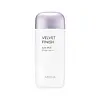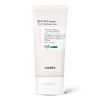What's inside
What's inside
 Key Ingredients
Key Ingredients

 Benefits
Benefits

 Concerns
Concerns

 Ingredients Side-by-side
Ingredients Side-by-side

Helichrysum Italicum Extract
AntiseborrhoeicCyclopentasiloxane
EmollientHomosalate
Skin ConditioningSilica
AbrasiveTitanium Dioxide
Cosmetic ColorantEthylhexyl Salicylate
UV AbsorberAlcohol
AntimicrobialDipropylene Glycol
HumectantLauryl PEG-10 Tris(Trimethylsiloxy)Silylethyl Dimethicone
EmulsifyingIsopropyl Palmitate
EmollientCaprylyl Methicone
Skin ConditioningDiethylamino Hydroxybenzoyl Hexyl Benzoate
UV FilterC12-15 Alkyl Benzoate
AntimicrobialBis-Ethylhexyloxyphenol Methoxyphenyl Triazine
Skin ConditioningAbronia Villosa Leaf Extract
Skin ConditioningPsidium Guajava Leaf Extract
AstringentAloe Barbadensis Leaf Extract
EmollientCinchona Succirubra Bark Extract
Skin ConditioningRhodiola Rosea Root Extract
EmollientRosa Damascena Flower Water
MaskingLeontopodium Alpinum Flower/Leaf Extract
Skin ConditioningWater
Skin ConditioningButylene Glycol
HumectantAluminum Hydroxide
EmollientMagnesium Sulfate
Stearic Acid
CleansingQuaternium-18 Bentonite
Dimethicone/Vinyl Dimethicone Crosspolymer
Skin ConditioningDimethicone
EmollientSilica Dimethyl Silylate
EmollientSodium Benzoate
MaskingTocopheryl Acetate
AntioxidantPotassium Sorbate
PreservativePolyhydroxystearic Acid
EmulsifyingEthylhexyl Palmitate
EmollientIsostearic Acid
CleansingLecithin
EmollientPolyglyceryl-3 Polyricinoleate
EmulsifyingVp/Hexadecene Copolymer
Acrylates/Dimethicone Copolymer
Skin ConditioningDisodium EDTA
Phenoxyethanol
PreservativeCaprylyl Glycol
EmollientEthylhexylglycerin
Skin ConditioningCI 77491
Cosmetic ColorantCI 77492
Cosmetic ColorantCI 77499
Cosmetic ColorantParfum
MaskingHelichrysum Italicum Extract, Cyclopentasiloxane, Homosalate, Silica, Titanium Dioxide, Ethylhexyl Salicylate, Alcohol, Dipropylene Glycol, Lauryl PEG-10 Tris(Trimethylsiloxy)Silylethyl Dimethicone, Isopropyl Palmitate, Caprylyl Methicone, Diethylamino Hydroxybenzoyl Hexyl Benzoate, C12-15 Alkyl Benzoate, Bis-Ethylhexyloxyphenol Methoxyphenyl Triazine, Abronia Villosa Leaf Extract, Psidium Guajava Leaf Extract, Aloe Barbadensis Leaf Extract, Cinchona Succirubra Bark Extract, Rhodiola Rosea Root Extract, Rosa Damascena Flower Water, Leontopodium Alpinum Flower/Leaf Extract, Water, Butylene Glycol, Aluminum Hydroxide, Magnesium Sulfate, Stearic Acid, Quaternium-18 Bentonite, Dimethicone/Vinyl Dimethicone Crosspolymer, Dimethicone, Silica Dimethyl Silylate, Sodium Benzoate, Tocopheryl Acetate, Potassium Sorbate, Polyhydroxystearic Acid, Ethylhexyl Palmitate, Isostearic Acid, Lecithin, Polyglyceryl-3 Polyricinoleate, Vp/Hexadecene Copolymer, Acrylates/Dimethicone Copolymer, Disodium EDTA, Phenoxyethanol, Caprylyl Glycol, Ethylhexylglycerin, CI 77491, CI 77492, CI 77499, Parfum
Aloe Barbadensis Leaf Water
MaskingHomosalate
Skin ConditioningButylene Glycol
HumectantDiethylamino Hydroxybenzoyl Hexyl Benzoate
UV FilterEthylhexyl Salicylate
UV AbsorberGlycerin
HumectantWater
Skin ConditioningBis-Ethylhexyloxyphenol Methoxyphenyl Triazine
Skin ConditioningC12-15 Alkyl Benzoate
AntimicrobialMethyl Trimethicone
Skin ConditioningNiacinamide
SmoothingCI 77891
Cosmetic ColorantDiisopropyl Sebacate
EmollientTerephthalylidene Dicamphor Sulfonic Acid
UV Absorber1,2-Hexanediol
Skin ConditioningPotassium Cetyl Phosphate
EmulsifyingCetearyl Alcohol
EmollientTromethamine
BufferingGlyceryl Stearate
EmollientBehenyl Alcohol
EmollientPolyacrylate Crosspolymer-6
Emulsion StabilisingXanthan Gum
EmulsifyingSodium Polyacryloyldimethyl Taurate
Emulsion StabilisingHydrogenated Lecithin
EmulsifyingPoly C10-30 Alkyl Acrylate
Emulsion StabilisingEthylhexylglycerin
Skin ConditioningStearic Acid
CleansingAluminum Hydroxide
EmollientPolyglyceryl-3 Methylglucose Distearate
EmulsifyingPalmitic Acid
EmollientCI 77491
Cosmetic ColorantDisodium EDTA
Triethoxycaprylylsilane
CI 77492
Cosmetic ColorantSodium Hyaluronate
HumectantAllantoin
Skin ConditioningMyristic Acid
CleansingCyanocobalamin
Skin ConditioningLauric Acid
CleansingTocopherol
AntioxidantAloe Barbadensis Leaf Water, Homosalate, Butylene Glycol, Diethylamino Hydroxybenzoyl Hexyl Benzoate, Ethylhexyl Salicylate, Glycerin, Water, Bis-Ethylhexyloxyphenol Methoxyphenyl Triazine, C12-15 Alkyl Benzoate, Methyl Trimethicone, Niacinamide, CI 77891, Diisopropyl Sebacate, Terephthalylidene Dicamphor Sulfonic Acid, 1,2-Hexanediol, Potassium Cetyl Phosphate, Cetearyl Alcohol, Tromethamine, Glyceryl Stearate, Behenyl Alcohol, Polyacrylate Crosspolymer-6, Xanthan Gum, Sodium Polyacryloyldimethyl Taurate, Hydrogenated Lecithin, Poly C10-30 Alkyl Acrylate, Ethylhexylglycerin, Stearic Acid, Aluminum Hydroxide, Polyglyceryl-3 Methylglucose Distearate, Palmitic Acid, CI 77491, Disodium EDTA, Triethoxycaprylylsilane, CI 77492, Sodium Hyaluronate, Allantoin, Myristic Acid, Cyanocobalamin, Lauric Acid, Tocopherol
 Reviews
Reviews

Ingredients Explained
These ingredients are found in both products.
Ingredients higher up in an ingredient list are typically present in a larger amount.
Aluminum Hydroxide is a form of aluminum. It can be naturally found in nature as the mineral gibbsite. In cosmetics, Aluminum Hydroxide is used as a colorant, pH adjuster, and absorbent.
As a colorant, Aluminum Hydroxide may add opacity, or reduce the transparency. Aluminum hydroxide is contains both basic and acidic properties.
According to manufacturers, this ingredient is an emollient and humectant. This means it helps hydrate the skin.
In medicine, this ingredient is used to help relieve heartburn and help heal ulcers.
There is currently no credible scientific evidence linking aluminum hydroxide in cosmetics to increased cancer risk.
Major health organizations allow the use of aluminum hydroxide in personal care products and have not flagged it as a carcinogenic risk at typical usage levels.
Learn more about Aluminum HydroxideYou might know this ingredient as Tinosorb S or Bemotrizinol. It is a UV filter that covers both UVA and UVB rays.
This ingredient has two peak UV absorption peaks ( 310 and 340 nm) and is able to absorb both UV-A and UV-B rays. This ingredient works by preventing UV rays from reaching and damaging your skin.
On top of that - it is highly photostable and helps prevent the photodegration of other sunscreen ingredients such as avobenzone.
Tinosorb S is allowed in the EU, Australia, and Asia. It is close to being approved by the FDA and we'll hopefully get this ingredient in the U.S. by late 2025.
Fun fact: Tinosorb S is the most effective UV absorber at maximum concentration (measured by SPF) permitted in the EU.
This ingredient is oil-soluble, so your oil-cleansers will take this right off at night.
Learn more about Bis-Ethylhexyloxyphenol Methoxyphenyl TriazineButylene Glycol (or BG) is used within cosmetic products for a few different reasons:
Overall, Butylene Glycol is a safe and well-rounded ingredient that works well with other ingredients.
Though this ingredient works well with most skin types, some people with sensitive skin may experience a reaction such as allergic rashes, closed comedones, or itchiness.
Learn more about Butylene GlycolC12-15 Alkyl Benzoate is made up of Benzoic Acid and long chain alcohols. It has a low molecular weight.
C12-15 Alkyl Benzoate is an emollient and texture enhancer. Due to its solubility, it is often used in sunscreens to help evenly distribute active ingredients.
As an emollient, C12-15 Alkyl Benzoate helps soften and hydrate your skin. Emollients create a film on your skin that traps moisture within.
This ingredient has been reported to cause eye irritation.
Learn more about C12-15 Alkyl BenzoateCi 77491 is also hydrated iron III oxide. It's sole purpose is to give a red/pink hue to products.
Iron III oxides are classified as inorganic chemicals for coloring.
Synthetically created Ci 77491 is considered safer than those naturally found. This is because the synthetically created version may contain less impurities. Iron oxides are generally non-toxic and non-allergenic.
Learn more about CI 77491Ci 77492 is also hydrated iron III oxide. It's sole purpose is to give a yellow hue to products.
Iron III oxides are classified as inorganic chemicals for coloring.
Synthetically created Ci 77492 is considered safer than those naturally found. This is because the synthetically created version may contain less impurities. Iron oxides are generally non-toxic and non-allergenic.
Learn more about CI 77492Diethylamino Hydroxybenzoyl Hexyl Benzoate (DHHB) is a chemical UV-A absorber. It is formulated for high UVA protection (320-400 nm).
DHHB is well-liked for:
DHHB has been approved by the EU, Japan, Taiwan, and South America for use up to 10%. Unfortunately, it has not been approved for use in the US or Canada due to slow regulatory processes.
This ingredient is soluble in oils, fats, and lipids.
Learn more about Diethylamino Hydroxybenzoyl Hexyl BenzoateDisodium EDTA plays a role in making products more stable by aiding other preservatives.
It is a chelating agent, meaning it neutralizes metal ions that may be found in a product.
Disodium EDTA is a salt of edetic acid and is found to be safe in cosmetic ingredients.
Learn more about Disodium EDTAEthylhexyl Salicylate is an organic compound used to block UV rays. It primarily absorbs UVB rays but offers a small amount of UVA protection as well.
Commonly found in sunscreens, Ethylhexyl Salicylate is created from salicylic acid and 2-ethylhexanol. You might know salicylic acid as the effective acne fighter ingredient and BHA.
The ethylhexanol in this ingredient is a fatty alcohol and helps hydrate your skin, similar to oils. It is an emollient, which means it traps moisture into the skin.
According to manufacturers, Ethylhexyl Salicylate absorbs UV wavelength of 295-315 nm, with a peak absorption at 307-310 nm. UVA rays are linked to long term skin damage, such as hyperpigmentation. UVB rays emit more energy and are capable of damaging our DNA. UVB rays cause sunburn.
Learn more about Ethylhexyl SalicylateEthylhexylglycerin (we can't pronounce this either) is commonly used as a preservative and skin softener. It is derived from glyceryl.
You might see Ethylhexylglycerin often paired with other preservatives such as phenoxyethanol. Ethylhexylglycerin has been found to increase the effectiveness of these other preservatives.
Homosalate is a chemical sunscreen filter that provides protection in the UV-B range (280nm - 320 nm), with a peak protection at 306 nm. It is internationally approved for use in sunscreens.
Homosalate is not photo-stable, meaning it's strength as a UV filter degrades over time with exposure to the sun. Because of this, it's often used in combination with other chemical sunscreen filters as avobenzone (which protects from the UV-A range). Homosalate also helps act as a solvent for harder-to-dissolve UV filters.
(Part of the reason that sunscreens need to be frequently re-applied is due to the photo instability of many chemical sunscreen filters)
Currently, homosalate is approved in concentrations up to 10% in the EU and 15% in the US. The FDA is currently doing further research on the effects of homosalate, and it is possible that these approved concentrations will change in the future.
Learn more about HomosalateStearic Acid is a fatty acid. It is an emollient, emulsifier, and texture enhancer.
As an emollient, stearic acid helps soften skin. It aids the skin's protective barrier by preventing water loss. It also provides a gentle cleansing effect without stripping away natural oils.
Stearic acid may also be used to enhance the texture of products. It can add volume and stabilize ingredients such as water and oil. This can help water and oil ingredients from separating.
Sources of stearic acid include animal or vegetable fats/oils such as coconut or shea. It can be naturally found in butter, cocoa butter, shea butter, vegetable fats, and animal tallow.
This ingredient may not be Malassezia folliculitis, or fungal-acne safe.
Learn more about Stearic AcidWater. It's the most common cosmetic ingredient of all. You'll usually see it at the top of ingredient lists, meaning that it makes up the largest part of the product.
So why is it so popular? Water most often acts as a solvent - this means that it helps dissolve other ingredients into the formulation.
You'll also recognize water as that liquid we all need to stay alive. If you see this, drink a glass of water. Stay hydrated!
Learn more about Water